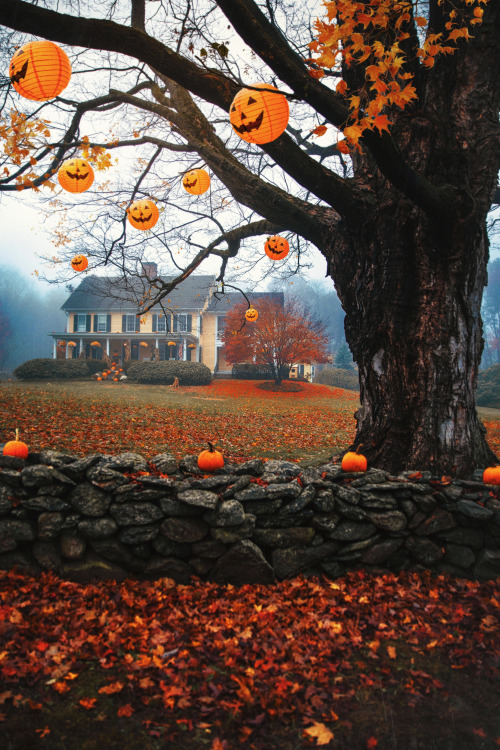Cozy Autumn Days

cozy autumn days
More Posts from Monstrous-mind and Others

Images of Saturn, Tethys, and Mimas taken by Cassini on July 16 2005.
Credit: NASA/JPL-Caltech/SSI/CICLOPS/Kevin M. Gill

🍁🍂🎃🌄

Wistfully Country on Pinterest.

🎃🍁🍂🎃

🔭🌃🌌
Cosmic Alphabet Soup: Classifying Stars

If you’ve spent much time stargazing, you may have noticed that while most stars look white, some are reddish or bluish. Their colors are more than just pretty – they tell us how hot the stars are. Studying their light in greater detail can tell us even more about what they’re like, including whether they have planets. Two women, Williamina Fleming and Annie Jump Cannon, created the system for classifying stars that we use today, and we’re building on their work to map out the universe.

By splitting starlight into spectra – detailed color patterns that often feature lots of dark lines – using a prism, astronomers can figure out a star’s temperature, how long it will burn, how massive it is, and even how big its habitable zone is. Our Sun’s spectrum looks like this:

Astronomers use spectra to categorize stars. Starting at the hottest and most massive, the star classes are O, B, A, F, G (like our Sun), K, M. Sounds like cosmic alphabet soup! But the letters aren’t just random – they largely stem from the work of two famous female astronomers.

Williamina Fleming, who worked as one of the famous “human computers” at the Harvard College Observatory starting in 1879, came up with a way to classify stars into 17 different types (categorized alphabetically A-Q) based on how strong the dark lines in their spectra were. She eventually classified more than 10,000 stars and discovered hundreds of cosmic objects!

That was back before they knew what caused the dark lines in spectra. Soon astronomers discovered that they’re linked to a star’s temperature. Using this newfound knowledge, Annie Jump Cannon – one of Fleming’s protégés – rearranged and simplified stellar classification to include just seven categories (O, B, A, F, G, K, M), ordered from highest to lowest temperature. She also classified more than 350,000 stars!

Type O stars are both the hottest and most massive in the new classification system. These giants can be a thousand times bigger than the Sun! Their lifespans are also around 1,000 times shorter than our Sun’s. They burn through their fuel so fast that they only live for around 10 million years. That’s part of the reason they only make up a tiny fraction of all the stars in the galaxy – they don’t stick around for very long.

As we move down the list from O to M, stars become progressively smaller, cooler, redder, and more common. Their habitable zones also shrink because the stars aren’t putting out as much energy. The plus side is that the tiniest stars can live for a really long time – around 100 billion years – because they burn through their fuel so slowly.

Astronomers can also learn about exoplanets – worlds that orbit other stars – by studying starlight. When a planet crosses in front of its host star, different kinds of molecules in the planet’s atmosphere absorb certain wavelengths of light.
By spreading the star’s light into a spectrum, astronomers can see which wavelengths have been absorbed to determine the exoplanet atmosphere’s chemical makeup. Our James Webb Space Telescope will use this method to try to find and study atmospheres around Earth-sized exoplanets – something that has never been done before.

Our upcoming Nancy Grace Roman Space Telescope will study the spectra from entire galaxies to build a 3D map of the cosmos. As light travels through our expanding universe, it stretches and its spectral lines shift toward longer, redder wavelengths. The longer light travels before reaching us, the redder it becomes. Roman will be able to see so far back that we could glimpse some of the first stars and galaxies that ever formed.
Learn more about how Roman will study the cosmos in our other posts:
Roman’s Family Portrait of Millions of Galaxies
New Rose-Colored Glasses for Roman
How Gravity Warps Light
Make sure to follow us on Tumblr for your regular dose of space!
🍁🍂🎃🍂🍁







🤎🌧️🍂Rainy fall days🍂🌧️🤎

What’s Up For September 2018?
Outstanding views Venus, Jupiter, Saturn and Mars with the naked eye!

You’ll have to look quickly after sunset to catch Venus. And through binoculars or a telescope, you’ll see Venus’s phase change dramatically during September - from nearly half phase to a larger thinner crescent!

Jupiter, Saturn and Mars continue their brilliant appearances this month. Look southwest after sunset.

Use the summer constellations help you trace the Milky Way.

Sagittarius: where stars and some brighter clumps appear as steam from the teapot.

Aquila: where the Eagle’s bright Star Altair, combined with Cygnus’s Deneb, and Lyra’s Vega mark the Summer Triangle.

Cassiopeia, the familiar “w”- shaped constellation completes the constellation trail through the Summer Milky Way. Binoculars will reveal double stars, clusters and nebulae.

Between September 12th and the 20th, watch the Moon pass from near Venus, above Jupiter, to the left of Saturn and finally above Mars!

Both Neptune and brighter Uranus can be spotted with some help from a telescope this month.

Look at about 1:00 a.m. local time or later in the southeastern sky. You can find Mercury just above Earth’s eastern horizon shortly before sunrise. Use the Moon as your guide on September 7 and 8th.

And although there are no major meteor showers in September, cometary dust appears in another late summer sight, the morning Zodiacal light. Try looking for it in the east on moonless mornings very close to sunrise. To learn more about the Zodiacal light, watch “What’s Up” from March 2018.

Watch the full What’s Up for September Video:
There are so many sights to see in the sky. To stay informed, subscribe to our What’s Up video series on Facebook.
Make sure to follow us on Tumblr for your regular dose of space: http://nasa.tumblr.com
🐈⬛🐈🍂🍁🎃☕🌌

-
 moonlight23 liked this · 1 year ago
moonlight23 liked this · 1 year ago -
 angrykitten69 reblogged this · 1 year ago
angrykitten69 reblogged this · 1 year ago -
 angrykitten69 liked this · 1 year ago
angrykitten69 liked this · 1 year ago -
 snika67-v2 reblogged this · 1 year ago
snika67-v2 reblogged this · 1 year ago -
 snika67-v2 liked this · 1 year ago
snika67-v2 liked this · 1 year ago -
 photog-jah liked this · 1 year ago
photog-jah liked this · 1 year ago -
 tuff-love liked this · 1 year ago
tuff-love liked this · 1 year ago -
 gothamdaddy liked this · 1 year ago
gothamdaddy liked this · 1 year ago -
 gr8-2sh reblogged this · 1 year ago
gr8-2sh reblogged this · 1 year ago -
 gr8-2sh liked this · 1 year ago
gr8-2sh liked this · 1 year ago -
 reservedkinkgrl reblogged this · 1 year ago
reservedkinkgrl reblogged this · 1 year ago -
 reservedkinkgrl liked this · 1 year ago
reservedkinkgrl liked this · 1 year ago -
 spiceyginger3 reblogged this · 1 year ago
spiceyginger3 reblogged this · 1 year ago -
 bibliophile-meow reblogged this · 1 year ago
bibliophile-meow reblogged this · 1 year ago -
 ray880990 liked this · 1 year ago
ray880990 liked this · 1 year ago -
 eyesinthemoon liked this · 4 years ago
eyesinthemoon liked this · 4 years ago -
 paperheartmalarky reblogged this · 4 years ago
paperheartmalarky reblogged this · 4 years ago -
 lyonofsaintmark reblogged this · 5 years ago
lyonofsaintmark reblogged this · 5 years ago -
 loveprettypictures liked this · 5 years ago
loveprettypictures liked this · 5 years ago -
 sophia-on-ice liked this · 5 years ago
sophia-on-ice liked this · 5 years ago -
 wisteria-in-the-garden liked this · 5 years ago
wisteria-in-the-garden liked this · 5 years ago -
 letsstopsleep liked this · 5 years ago
letsstopsleep liked this · 5 years ago -
 oceanwaves-xo reblogged this · 5 years ago
oceanwaves-xo reblogged this · 5 years ago
My ambition is handicapped by laziness. -C. Bukowski Me gustan las personas desesperadas con mentes rotas y destinos rotos. Están llenos de sorpresas y explosiones. -C. Bukowski. I love cats. Born in the early 80's, raised in the 90's. I like Nature, Autumn, books, landscapes, cold days, cloudy Windy days, space, Science, Paleontology, Biology, Astronomy, History, Social Sciences, Drawing, spending the night watching at the stars, Rick & Morty. I'm a lazy ass.
222 posts